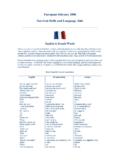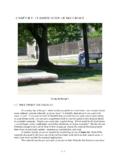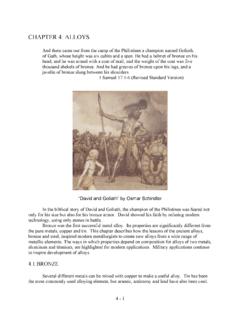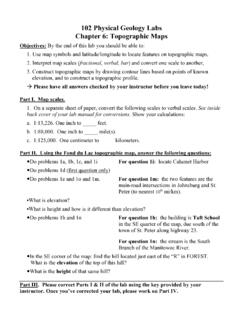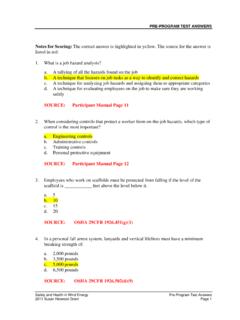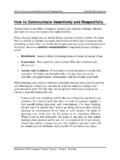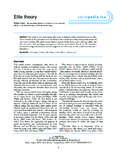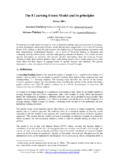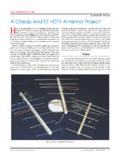Transcription of Sigmund Freud Summary - University of Wisconsin …
1 The Interpretation of Dreams Sigmund Freud Summary : The Interpretation of Dreams is a book by psychoanalyst Sigmund Freud . The first edition (in German, and bearing the title Die Traumdeutung) was published in November 1899 (post-dated as 1900 by the publisher). The book inaugurated the theory of Freudian dream analysis, which activity Freud famously described as "the royal road to the understanding of unconscious mental processes." At the beginning of Chapter One, Freud describes his work thus: In the following pages, I shall demonstrate that there is a psychological technique which makes it possible to interpret dreams, and that on the application of this technique, every dream will reveal itself as a psychological structure, full of significance, and one which may be assigned to a specific place in the psychic activities of the waking state.
2 Further, I shall endeavour to elucidate the processes which underlie the strangeness and obscurity of dreams, and to deduce from these processes the nature of the psychic forces whose conflict or co-operation is responsible for our dreams. The book introduces Freud 's theory of the unconscious with respect to dream interpretation. Dreams, in Freud 's view, were all forms of "wish-fulfillment" attempts by the unconscious to resolve a conflict of some sort, whether something recent or something from the recesses of the past (later in Beyond the Pleasure Principle, Freud would discuss dreams which did not appear to be wish-fulfillment). However, because the information in the unconscious is in an unruly and often disturbing form, a "censor" in the preconscious will not allow it to pass unaltered into the conscious.
3 During dreams, the preconscious is more lax in this duty than in waking hours, but is still attentive: as such, the unconscious must distort and warp the meaning of its information to make it through the censorship. As such, images in dreams are often not what they appear to be, according to Freud , and need deeper interpretation if they are to inform on the structures of the unconscious. Freud makes his argument by first reviewing previous scientific work on dream analysis, which he finds interesting but inadequate. He then describes a number of dreams which illustrate his theory. Many of his most important dreams are his own his method is inaugurated with an analysis of his dream "Irma's injection" but many also come from patient case studies.
4 Much of Freud 's sources for analysis are in literature, and the book is itself as much a self-conscious attempt at literary analysis as it is a psychological study. Freud here also first discusses what would later become the theory of the Oedipus complex. The initial print run of the book was very low it took many years to sell out the first 600 copies. Widely considered to be his most important contribution to psychology, Freud said of this work, "Insight such as this falls to one's lot but once in a lifetime." Freud 's Life: On May 6, 1856, Sigismund Schlomo Freud was born in the small Moravian town of Freiberg. His parents were Jakob and Amalie Freud .
5 Over the next six years Amalie gave birth to six more children. Sigmund was always the favorite child. Jakob's textile business failed, and in 1860, the family moved to Vienna, spending almost a year in Leipzig on the way. In Vienna, Freud was a studious and serious child. He was schooled at home, first by his mother and then by his father, and then he joined the Sperl Gymnasium, where he was at the top of his class. In 1873, Freud graduated from the Sperl Gymnasium at the early age of seventeen and started medical training at the University of Vienna. It took him eight years to receive his medical degree, in part because he was distracted by scientific research.
6 This was especially true in the later years of his medical studies (1877 1881), when was working in the laboratory of his mentor, Ernst Br cke, on the anatomy of the brain. 1881 was a momentous year for Freud : he met Martha Bernays and became engaged to her secretly, at first and he finally received his medical degree. In 1882, he left Br cke's lab and took a position at the Vienna General Hospital, motivated in part by his desire to make enough money to be able to marry Martha. Over the next five years he moved from department to department at the hospital, passing through surgery and dermatology before coming to rest at Theodor Meynert's department of psychiatry.
7 In the winter of 1885 1886, Freud went to Paris to study under Jean-Martin Charcot at the Salp tri re. He was finally married to Martha Bernays in the summer of 1886. They first married in a civil ceremony, but when they discovered that Austria (unlike Germany) would not officially recognize a nonreligious marriage, they married in a Jewish one. Over the next ten years, from 1886 1896, Freud continued to develop his private practice. By the beginning of the 1890s, his relationship with Josef Breuer, another Jewish neurologist, had flourished. The two men had collaborated on the publication of a series of case studies on their patients called Studies on Hysteria.
8 This contained one case study by Breuer and four by Freud . The case study by Breuer, on the patient "Anna O.", is known as the first psychoanalytic case study. In it, Breuer discusses the "cathartic method" he used to cure Anna O.'s symptoms by discovering, with her help, the earlier, unconscious traumas that were associated with her symptoms. Although Freud was enthusiastic about the new method, his emphasis on the exclusively sexual causes of hysteria made his theories unpopular, not only with his superiors at the University , but also with Breuer. From 1896 1901, in a period of isolation from his colleagues, Freud developed the basics of psychoanalytic theory out of the raw material of his patients, his conversations with Breuer, and his correspondence with a new friend, the Berlin nose and throat doctor Wilhelm Fliess.
9 In 1899, Freud 's The Interpretation of Dreams, the first fully fleshed-out psychoanalytic work, was published. Freud was deeply disappointed by its lackluster reception, but he continued writing. His The Psychopathology of Everyday Life was published in 1901, and his Three Essays on the Theory of Sexuality was published in 1905. In the 1900s, Freud finally emerged from the isolation that had characterized his professional life in the 1890s. He began to have weekly meetings at his house to discuss psychoanalytic theory. The group that met at his house was called the "Wednesday Psychological Society," and eventually it grew into the Vienna Psycho-Analytic Society.
10 By 1904, Freud had begun to hear of other neurologists and psychiatrists using his techniques. He was particularly excited to hear that the well-respected Swiss psychiatrist Eugen Bleuler and one of Bleuler's staff members, Carl G. Jung, had taken an interest. Toward the end of the decade, psychoanalysis became a truly international affair: the International Psychoanalytic Association was founded with the help of supporters from Germany, Austria (Alfred Adler and Wilhelm Stekel), Switzerland, Hungary (Sandor Ferenczi), and England (Ernest Jones). In the years before the First World War, psychoanalysis experienced its first growing pains: first Jung, then Adler and Stekel, left the organization after bitter disagreements with Freud .
